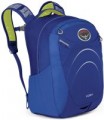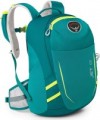Capacity
The total volume of the product. It can be indicated both with external pockets and without them (see "Compartments") — this is not critical in this case, because the capacity of the pockets is small and does not really affect the overall capacity. But the external compartment (see ibid.) is necessarily taken into account in the characteristics, since it accounts for a fairly significant part of the volume.
Larger capacity allows you to carry more items inside. On the other hand, for pupils of primary and secondary grades, capacious backpacks are not required, and a heavy load can be harmful to health and normal development. Therefore, the volume largely depends on the age category. Thus, the volume of backpacks (see "Type"), which were originally designed for the younger age group, rarely exceeds 20 liters, and in most cases is less than 15 liters. The same applies to bags, but in their case it is more likely due to design features, and the volume is generally larger — up to 29 liters. Backpacks are the most voluminous — among them models of 25 liters are not uncommon, and in some
the volume exceeds 30 liters. However, the choice of volume depends not only on the age category, but also on the expected amount of cargo. So, a high school student may not need a roomy backpack if the school has lockers and textbooks are mostly stored there.
Compartments
Additional compartments provided in the design of the product (in addition to the main one).
—
External. Additional compartment with a separate fastener, located on the outside of the backpack (on the opposite side from the back). It can have different sizes: most often, the outer compartment occupies the entire height and width of the backpack, but in some models it is made in the form of a relatively small additional pocket. Anyway, this feature allows you to organize the contents of the backpack by placing it in the appropriate compartments: for example, you can keep textbooks in a larger compartment, notebooks in a smaller one.
—
Penal. A small outer compartment designed for any small things; the name "pencil case" hints at the fact that it is designed for pens, pencils, erasers and other stationery, but in fact you can hold any small items there. Thanks to this, they are not lost in the main compartment, and you can get to the contents of the pencil case quite easily and quickly. Moreover, an organizer can be provided inside — a set of pockets for stationery; however, in some backpacks, the organizer is placed in the main or external compartment. Do not confuse this function with a separate pencil case (see "Additional") — we are talking about the built-in compartment.
—
Bottle pocket. A separate pocket for carrying bottles and other i
...tems of a similar shape — thermoses, umbrellas, etc. It is usually located outside, on the side end of the product, and is made in the form of an elastic mesh capable of "holding" the object placed inside. Often there are two such pockets, on both sides. The bottle pocket is convenient because you can get to its contents without opening the main compartments, and with a certain skill, even without removing the entire backpack: just remove one strap and put your hand behind your back. In some models, one of the bottle pockets is also regularly used as a seat for a complete pencil case (see "Additional").
— Side pocket. Like the pocket for a bottle (see above), such a pocket is located on the side end and there may be more than one. The main difference lies primarily in the form and purpose: side pockets are usually made for flat and/or small items. In addition, they are often equipped with zippers or other closing devices. The side pocket is usually not connected to the main compartment, it is convenient to store various small things in it, which can be “lost” inside the bag / knapsack / backpack, or which need quick access.
— Hidden pocket. A secret pocket, usually, is located on the back of the backpack. Thus, when the backpack hangs on the shoulders, the pocket is hidden from view and from access to the contents. This is especially convenient when carrying small valuable items, because. gives maximum protection against theft.
— Internal dividers. Partitions dividing the main compartment of the backpack into several parts. This design makes it easier to put the contents in order: for example, textbooks, notebooks and inventory for a labor lesson can be separated by partitions. At the same time, partitions are more convenient than the division into the main and outer compartments (see above): just open the backpack — and all the contents will immediately be at hand, you do not have to unfasten / fasten each compartment separately. Also note that one of the separators can block off a special seat for a laptop or tablet.Weight
Empty weight. This parameter has a dual meaning. On the one hand, the lower the own weight of a backpack, bag or knapsack, the less load will be on the shoulders of the child with the same weight of the load. On the other hand, with the same materials, a lighter product is also thinner and, accordingly, less durable.

